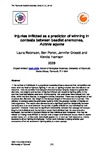Injuries inflicted as a predictor of winning in contests between beadlet anemones, Actinia equina
| dc.contributor.author | Robinson, L. | |
| dc.contributor.author | Porter, B. | |
| dc.contributor.author | Grocott, J. | |
| dc.contributor.author | Harrison, K. | |
| dc.date.accessioned | 2019-05-13T10:05:08Z | |
| dc.date.available | 2019-05-13T10:05:08Z | |
| dc.date.issued | 2009 | |
| dc.identifier.citation |
Robinson, L., Porter, B., Grocott, J., Harrison, K. (2009) 'Injuries inflicted as a predictor of winning in contests between beadlet anemones, Actinia equina', The Plymouth Student Scientist, p. 32-49. | en_US |
| dc.identifier.issn | 1754-2383 | |
| dc.identifier.uri | http://hdl.handle.net/10026.1/13852 | |
| dc.description.abstract |
If the number of individuals in a population oversubscribes a resource then competition can occur and may lead to injurious fighting, if the cost of fighting is lower than the value of the resource. Here we consider how weapon size (nematocyst length), body size (pedal disc diameter, wet weight) and number of injuries inflicted are related to fighting ability in the common intertidal beadlet anemone, Actinia equina. 160 anemones were utilised from two sites, within two size classes, to engage in contest behaviour. There was no significant effect on pedal disc diameter, wet weight or nematocyst length of the outcome of a contest. The winners of contests were the anemones found to inflict the greatest number of injuries on their opponents. The results also demonstrated a significant positive relationship between the body size of an anemone and the number of peels inflicted on that individual by their opponent. However, there was no significant relationship between the average nematocyst length of an individual and the number of scars that individual had. As anemone size increased, the number of injuries inflicted on that individual also increased. This may be related to it being more difficult to triumph over a larger anemone and so you have to cause greater injury to it. In this study, individuals appear not to ‘size up’ their opponents, merely escalate to all out fighting immediately. Further work includes studying whether past encounters affect an anemone’s fighting ability in a later contest. | en_US |
| dc.language.iso | en | en_US |
| dc.publisher | University of Plymouth | |
| dc.rights | Attribution 3.0 United States | * |
| dc.rights.uri | http://creativecommons.org/licenses/by/3.0/us/ | * |
| dc.subject | Intertidal | en_US |
| dc.subject | Fighting | en_US |
| dc.subject | Nematocyst | en_US |
| dc.subject | Actinia Equina | en_US |
| dc.subject | Anemone | en_US |
| dc.title | Injuries inflicted as a predictor of winning in contests between beadlet anemones, Actinia equina | en_US |
| dc.type | Article | |
| plymouth.issue | 1 | |
| plymouth.volume | 2 | |
| plymouth.journal | The Plymouth Student Scientist |



